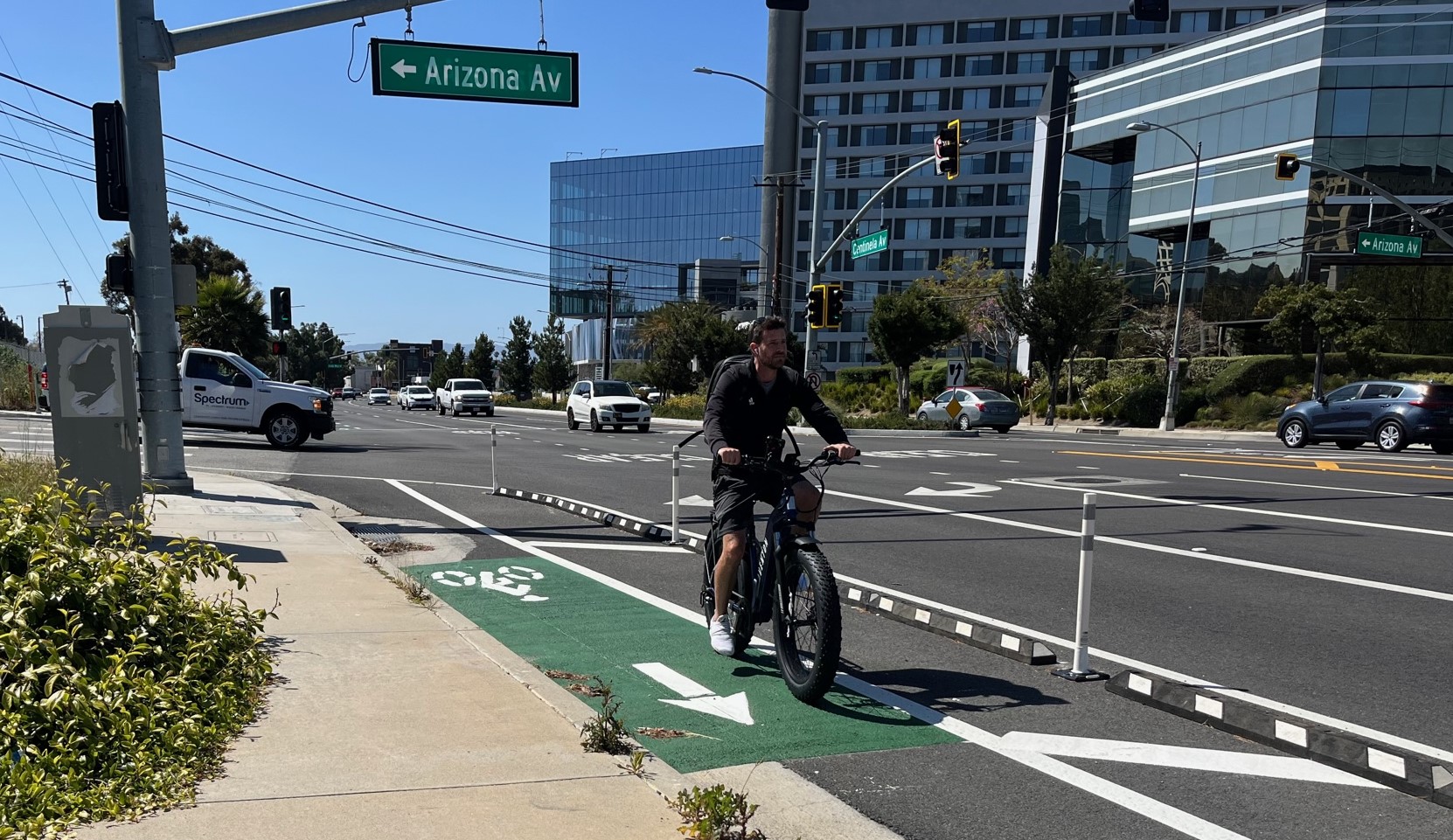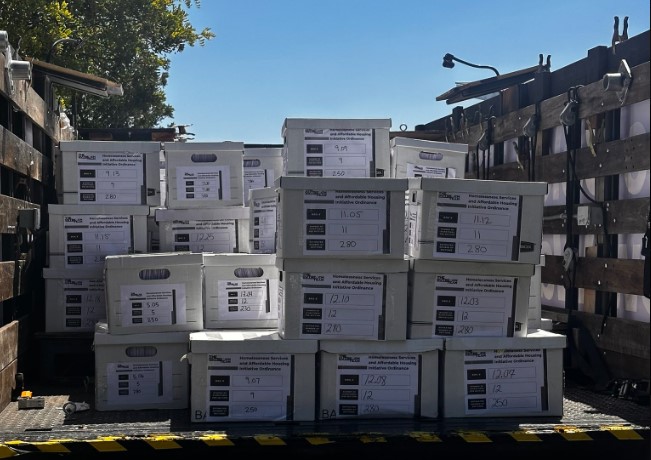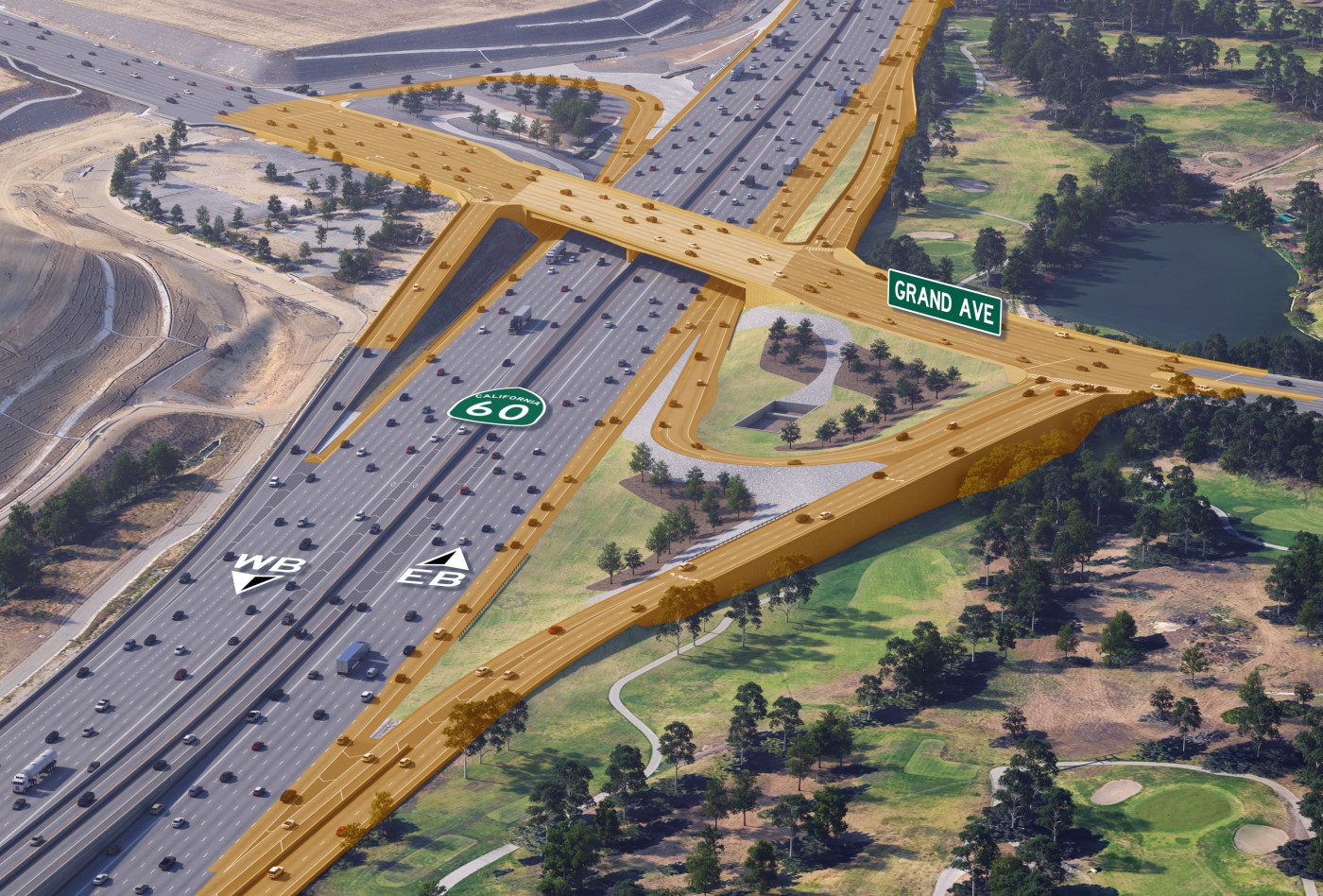Proposed Rule Meant to Curb Stink from Animal Rendering Plants
6:59 PM PDT on October 24, 2017
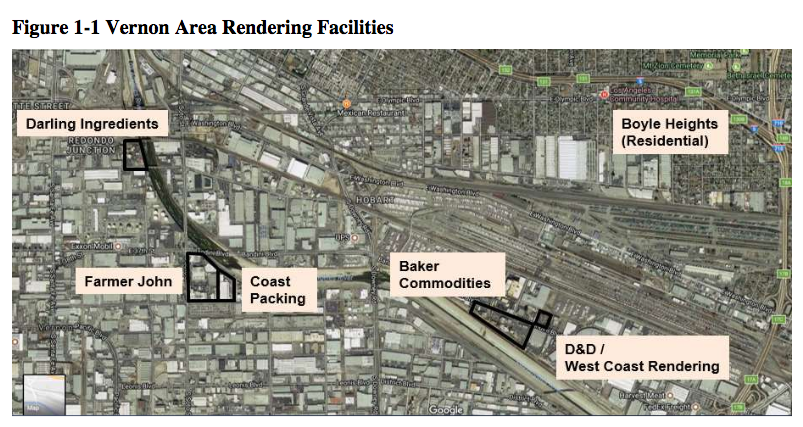
Within the South Coast Air Basin, there are five rendering facilities: Baker
Commodities,
Farmer John/Smithfield Foods, D & D Disposal/West Coast Rendering, Coast
Packing, and Darling Ingredients. Source: AQMD
Last night, the South Coast Air Quality Management District (AQMD) held a meeting regarding a proposed rule meant to curb the rancid-cat-food-slash-sewage smells that often waft over the southern half of Boyle Heights.
Proposed Rule 415 would require the five facilities in and adjacent to Vernon that slaughter animals and/or render and process animal byproducts - including that of dead livestock, shelter animals, pets, and road-kill - be enclosed to mitigate odors over the long term and that best practices for odor management and responses to complaints be implemented immediately.
The change is decades overdue - something councilmember José Huizar noted in his opening remarks to those gathered at Resurrection Church, saying he, too, had grown up with those smells, and that they had impacted the amount of time families spent outdoors.
"We have to ask ourselves, 'If this was any in other community being impacted like this...would they have been allowed to continue [to emit] these odors [that are] going out and affecting the community?'"
The question is, at this point, essentially a rhetorical one. As cities grew and whites took flight for greener, cleaner pastures, white communities were zoned to ensure polluting industries were kept at a healthy distance. Communities of color were afforded no such protections then and often continue to be denied protections now, even as they grow in density around historically industrial areas.
As we saw with the decade-plus-long battle to get Exide's lead-acid battery plant shuttered, it took comparisons to the rapid response to the gas leak in Aliso Canyon for the state to be willing to dig into its pockets to help speed residential cleanups of lead in East and Southeast L.A.
With regard to the animal rendering plants, in particular, hundreds of complaints had to be lodged throughout the 1990s, as documented by David Bloom, before Darling Ingredients (a meat renderer with a terrible track record around the U.S. at the time) was finally forced to slow down operations in order to enclose its carcass pits and install chemical scrubbers on them to clean the fumes.
The complaints were not about emissions - awful as rotting flesh can smell, it isn't technically toxic. But it can make people feel ill and can put the outdoors or even the opening of a window just out of reach.
Even then, however, health experts lamented that not dealing with the pile-up of dead cows resulting from the slow-down of Darling's operations was harmful to the communities where the carcasses were festering. In the end, state agricultural officials waded into the negotiations to the detriment of the communities around the plant: the AQMD ended up granting the renderer a three-year extension on the installation of one of the scrubbers so Darling could resume operations.
More recently, complaints about the stench have tapered off - averaging about 35 a year between 2002 and 2011. It's not that much has changed with regard to the way animals are processed or the quantity the renderers receive - in fact, that appears to remain as constant and as unhappy as ever.
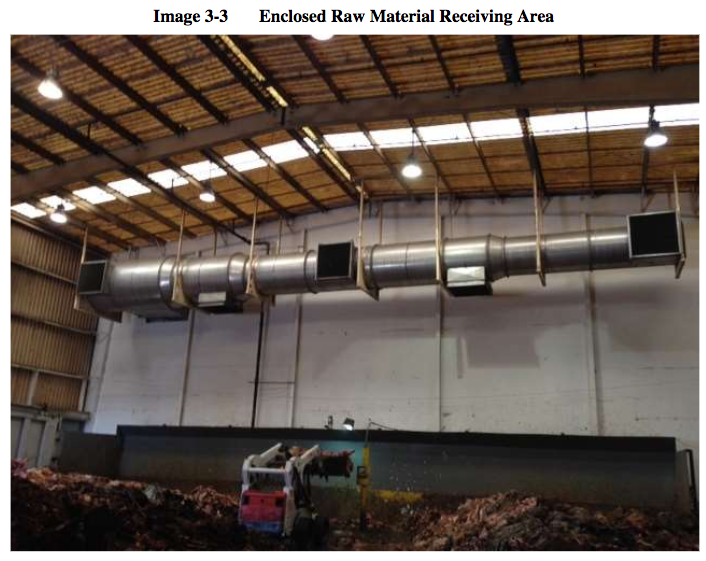
Thousands of pounds of carcasses and other raw materials continue to be brought in on uncovered trucks, dropped off in open-air warehouses (or worse, on the lot) where they might rot for some time before processing, or kept in open-air containers as they're transferred from place to place on-site (below).
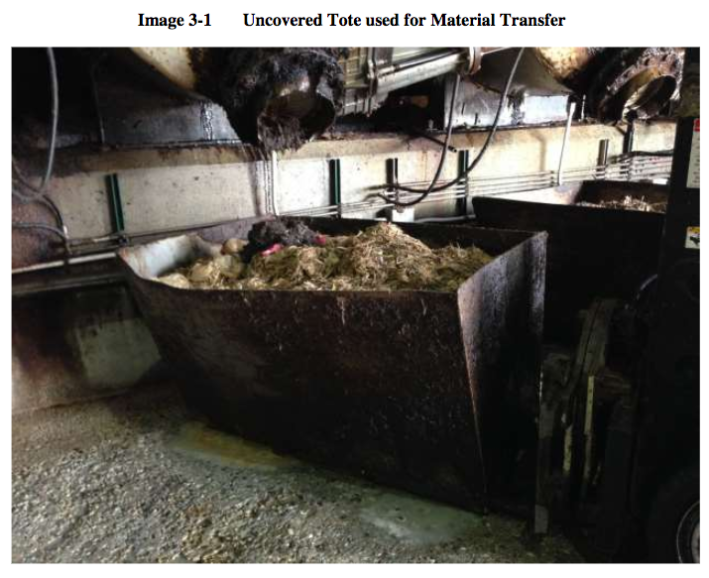
Instead, the drop-off in complaints, AQMD rule-making staff suggest in a 2015 draft proposal, is likely due to the community's expectation that no action would be taken to remedy the situation.
The community was not wrong to be pessimistic - that same draft report notes that most of the odor complaints filed were never verified by an inspector.
"We did know for years and years and years that we had been getting complaints and calls from the community," acknowledged Tracy Goss, AQMD Planning and Rules Manager, at last night's meeting. "But at the time, we just weren't there to write regulation. But now we are."
The current process to put PR415 in place has been underway since November of 2014. The effort is an outgrowth of the Boyle Heights Clean Community Plan pilot project - a program launched in 2010 to foster better coordination among agencies and responsiveness to communities in order to reduce exposure to toxins and address cumulative air quality issues. But progress stalled unexpectedly over the last two years.
In early 2015, as the AQMD was concluding its site visits and putting together the specifics of the proposed rule, staff noted that Coast Packing had still "not allowed rule development staff to make a site visit."
The city of Vernon was also proving to be an obstacle, with Peter Corselli, a member of the city-created Vernon Green Commission, telling EGP News, "This rule is based on nothing but a completely subjective nose."
Citing the same slippery-slope argument others in Vernon had made, Corselli insinuated the effort to crack down on gag-inducing odors was tied to something more sinister, arguing, “I wouldn’t be surprised if they saw Exide as a triumph and are now moving on to the next target.”
It's a claim that hints at just how skewed things can get in Vernon when business is at stake.
In 2011, efforts to disincorporate the city of 113 residents, both as a way to address rampant corruption there and to hold polluters more accountable, failed after business and labor interests pressured state senator Kevin de León to back away from a bill he had originally helped write. Then, as now, concerns about potential impacts of regulations on the 50,000-plus jobs the city houses made an effective platform from which to lobby regulators and pit workers against the health concerns of their working-class neighbors.
The business owners also complained to rule-making staff that any further regulation would be prohibitively costly, harm their ability to conduct normal operations, and make it difficult for them to stay in Vernon. Considering the facilities were not only not in violation of emissions standards but were also "green" (in that they provided a valuable service that prevented the emission of greenhouse gases), some complained, the AQMD either lacked the authority or outright had no cause to regulate them [see comments, starting p. 75].
For its part, the AQMD responded, it did indeed have the jurisdiction and cause to regulate. But the pushback they received appears to have been enough to stall the process - rule-making was wholesale suspended from mid-2015 until just this past September.
Now that the process has resumed, it appears to be moving along quickly. The goal of engaging stakeholders last night was to inform them of what the proposed rule entailed and get one last round of input before the rule went before the board for approval on November 3.
Should the rule be approved, Goss told attendees, it would still be some time before major changes could be implemented. Fully enclosing receiving facilities and properly venting gases through air pollution control devices, proper management and treatment of wastewater, and proper venting of high temperature cooking areas involves renovations and substantial funds.
The businesses would have a year to make their claims, submit their permits, and secure the financing (costs are expected to run between $2 and $3 million spread out over several years), he said. The AQMD would respond within six months, and then the businesses would have up to three-and-a-half years to complete the renovations, depending on the type of facility in question. [See breakdown of costs, etc. here.]
In the meanwhile, however, Goss said the rule would also seek to bring the businesses into compliance with best practices that could be implemented immediately and at low cost, including
- ensuring trucks transporting animal remains were covered;
- unloading remains into enclosed areas whenever possible;
- moving remains to enclosed areas within a limited space of time;
- washing transport trucks before they leave the facility;
- repairing potholes and cracks to avoid animal matter getting wedged into spaces where it could fester;
- moving raw or cooked materials within enclosed containers on-site;
- washing down any containers that contained remains.
Signage would also be posted on facilities directing residents to call 1-800-CUT-SMOG to make complaints when odors persisted.
As a regulatory agency, Goss had said early on in his presentation, the AQMD needed to acknowledge that the services these businesses rendered were important. But he also made clear that bettering the environment for the community was an equally important goal.
Find the final draft of the proposed rule here. Watch Huizar's remarks and the presentation by the AQMD here. Learn more about the sheer scale of the local animal rendering industry here and here. The rule will be heard by the governing board of the AQMD on November 3 at 9 a.m. (find details here). If you'd like to submit comments regarding the rule, please submit them to tgoss[at]aqmd.gov or call (909) 396-3106.
Sahra is Communities Editor for Streetsblog L.A., covering the intersection of mobility with race, class, history, representation, policing, housing, health, culture, community, and access to the public space in Boyle Heights and South Central Los Angeles.
Stay in touch
Sign up for our free newsletter
More from Streetsblog Los Angeles
Eyes on the Street: Recent Centinela Bike Lanes in Culver City
The new partially-protected Centinela facility is a welcome safety upgrade for a stretch that long lacked any type of bikeway, but the area remains not all that bike-friendly
This Week In Livable Streets
Bike Month continues, Metro 91 Freeway widening, Destination Crenshaw, Culver City Bus, Santa Monica MANGo, Metro bike lockers, Metro Sepulveda Transit, and more
San Fernando Valley Bus/Bike Updates: G Line, Roscoe Bus Lanes, Laurel Canyon Bike Lanes
Short newly protected bike lane on Laurel Canyon Blvd, extensive NSFV bus improvements under construction this month, and scaled-back G Line plans should get that project under construction this summer
